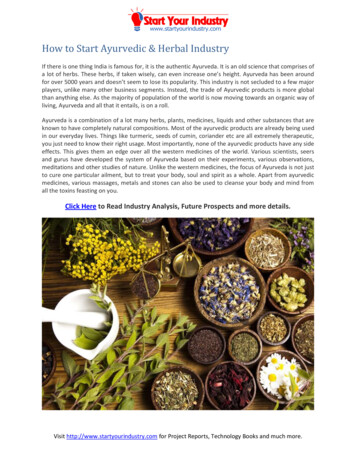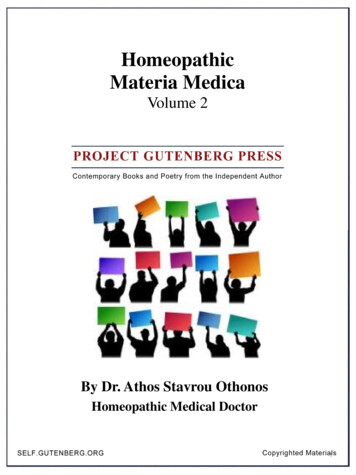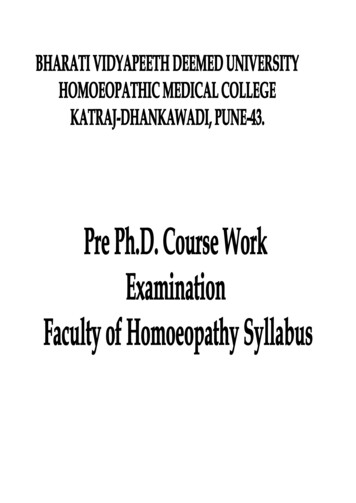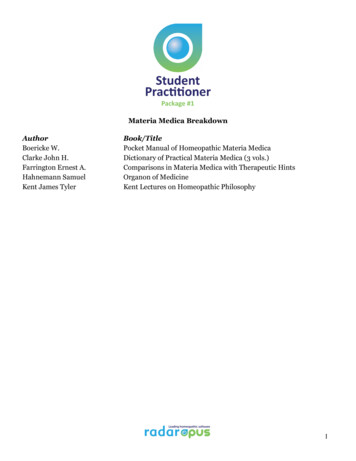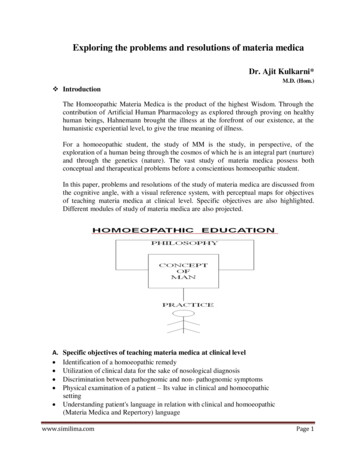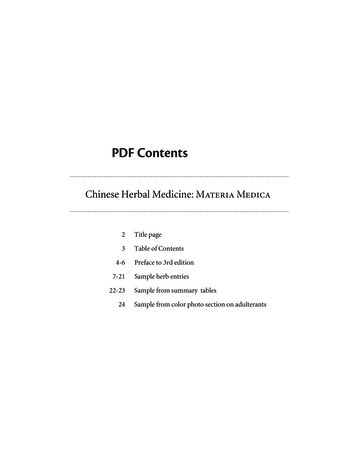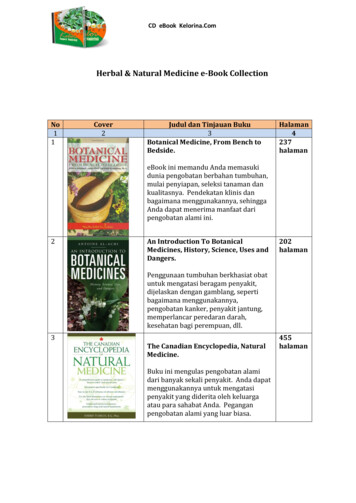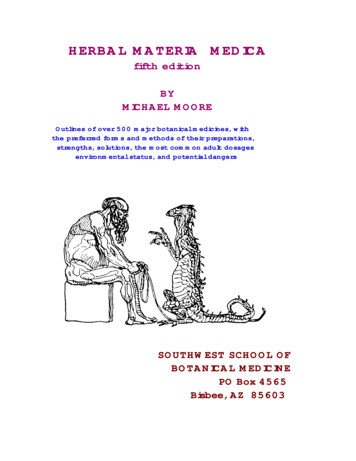
Transcription
SUBJECT OUTLINESubject Name:Subject Code:Herbal Medicine Materia Medica 1WHMF112SECTION 1 – GENERAL INFORMATIONAward/s:Total Course Credit Points:Bachelor of Health Science (Naturopathy)Duration:1 SemesterSubject is:Core128Subject Credit Points:Level:1st Year2Student Workload:No. timetabled hours per week:3No. personal study hours per week:2Total hours per week:5Delivery Mode*: On campus Online / Digital Blended IntensiveWeekly Session Format/s - 1 session per week: Livestream lectures: 2 hours 3 hours1 x 3 hour lecture includesintegrated practical skills session*All modes are supported by the online learning management system which will include subject documents suchas handouts, readings and assessment guides. A ‘session’ is made up of 3 hours of timetabled / online study time per week unless otherwise specified. Eachsubject has a set number of sessions as outlined above.Note: As they are aware, international students on a Student Visa (500) must attend livestream classes on theirlocal campus, using the Virtual Classrooms provided.Study Pattern: Full Time Part TimePre-requisites:BIOB111, BIOH111Co-requisites:BIOH122SECTION 2 – ACADEMIC DETAILSSubject RationaleThis is the first of two subjects that explore plants used in the practice of Naturopathy and Herbal Medicine. Eachherb is investigated from the perspective of its taxonomy and morphology, natural chemical constituents,therapeutic actions and applications, administration and dosage. This investigation considers both the traditionaland historical use of the herbs as well as relevant research-based evidence. The materia medica is explored inrelation to physiological systems and the herbs that exert a primary influence on particular systems. Students areintroduced to herbal medicine management of clinical cases. This subject prepares students for the study of HerbalPharmacology and Pharmacognosy and Clinical Herbal Medicine.Australian College of Natural Medicine Pty Ltd trading as Endeavour College of Natural Health, FIAFitnation (National CRICOS #00231G, RTO #31489)WHMF112 Herbal Medicine Materia Medica 1Last modified: 11-Jun-2021Version: 11.0Page 1 of 6
Learning Outcomes1.Examine the therapeutic actions and applications of herbs from a traditional and contemporary perspective.2.Develop an herbal report through investigation of available evidence (traditional and scientific) on plantmedicines.3.Apply knowledge of herbal materia medica to simple cases based on specific therapeutic action and clinicalindications.4.Examine the benefits and risks of herbal medicine in the management of human health conditions.Assessment TasksTypeLearning OutcomesAssessedSession ContentDeliveredDueWeighting1 & 3-41-6Session 725%1-2 & 41-9Week 1035%1-13FinalExaminationPeriod40%Mid-semester WrittenExamShort answer and Casestudies(1 hour)Herbal Report(1000 words)Final Written ExamMultiple choice, Shortanswer, case studies1 & 3-4(1.5 hours)All written assessments and online quizzes are due at 11:55 p.m. Sunday and submitted through the LMSPrescribed Readings:1. Braun, L., & Cohen, M. (2015). Herbs and natural supplements: An evidence-based guide (4th ed., Vol. 1).Elsevier. [ebook available]2. Braun, L., & Cohen, M. (2015). Herbs and natural supplements: An evidence-based guide (4th ed., Vol. 2).Elsevier. [ebook available]3. Fisher, C. (2018). Materia medica of Western herbs. Aeon Books. [eBook available]4. Pittler, M. H., & Ernst, E. (2000). Ginkgo biloba extract for the treatment of intermittent claudication: A metaanalysis of randomized trials. The American Journal of Medicine, 108(4), 4-4Recommended Readings:1. American Botanical Council. (2013). Herbal medicine: ralian College of Natural Medicine Pty Ltd trading as Endeavour College of Natural Health, FIAFitnation (National CRICOS #00231G, RTO #31489)WHMF112 Herbal Medicine Materia Medica 1Last modified: 11-Jun-2021Version: 11.0Page 2 of 6
2. Barnes, J., Anderson, L. A., Phillipson, J. D., Veitch, N. C., & Smith, M. (Eds.) (2014). Herbal medicine (4thed.). Pharmaceutical Press. [ebook available]3. Bone, K. (2003). A clinical guide to blending liquid herbs: Herbal formulations for the individual patient. ChurchillLivingstone. [ebook available]4. Bone, K. (1996). Clinical applications of ayurvedic and Chinese herbs: Monographs for the Western herbalpractitioner. Phytotherapy Press.5. Mills, S. & Bone, K. (2013). Principles and practice of phytotherapy: Modern herbal medicine (2nd ed.).Churchill Livingstone Elsevier. [ebook available]6. Tobyn, G., Denham, A., & Whitelegg, M. (2011). The Western herbal tradition: 2000 years of medicinal plantknowledge. Churchill Livingston Elsevier. [ebook available]7. Wood, M. (2008). The Earthwise herbal. A complete guide to old world medicinal plants. North Atlantic Books.[ebook available]8. Wood, M. (2009). The Earthwise herbal. A complete guide to new world medicinal plants. North Atlantic Books.[ebook available]9. Wood, M. (2004). The practice of traditional Western herbal medicine: Basic doctrine, energetics andclassification. North Atlantic Books. [ebook available]Subject ContentWeek1.LecturesTutorials / PracticalsIntroduction (Subject Outline / Subject Aims /Assessment / Teaching Resources)Activities are developed to allow the students toexplore relevant concepts, expand on ideas andhave peer and lecturer interaction. Activities alsoallow for formative assessment and feedback.Materia MedicaHistory of Materia Medicao European, American, Indigenous Australianetc.Explore relevant concepts and expand onideas with peer and lecture / tutor interactionOrigins and key figures throughout history whohave contributed to its foundation (e.g.,Dioscorides, Galen, Paracelsus)Therapeutic actions2.Philosophies and Principles of HerbalMedicineExplore relevant concepts and expand onideas with peer and lecture / tutor interactionPhilosophies and principles of herbal medicineChoosing the most appropriate herbal medicinepreparationTraditional and modern herbal preparations andderivatives (drug extract ratio)Therapeutic actions3.PosologyCharacteristics of herbal formulations (synergy,balance, supporting / stimulating etc. herbs)Explore concepts and expand on ideas withpeer and lecture / tutor interactionTraditional prescribingAustralian College of Natural Medicine Pty Ltd trading as Endeavour College of Natural Health, FIAFitnation (National CRICOS #00231G, RTO #31489)WHMF112 Herbal Medicine Materia Medica 1Last modified: 11-Jun-2021Version: 11.0Page 3 of 6
DosageCase study deconstructionLabellingTherapeutic actions4.Respiratory Herbs - Part ILibrary database research sessionUpper respiratory tractDiscussion of related clinical scenarios andappropriate herbal therapeutic approachesMateria medicao Albizia lebbeck, Armoracia rusticana,Euphrasia officinalis, Sambucus nigra,Solidago virgaurea, Tanacetum partheniumfrom traditional and scientific literature5.Respiratory Herbs - Part 2Discussion of related clinical scenarios andappropriate herbal therapeutic approachesLower respiratory tractMateria medicao Achillea millefolium, Althaea officinalis,Hedera helix, Marrubrium vulgare, Plantagolanceolata, Prunus serotina, Verbascumthapsus, from traditional and scientificliterature6.Respiratory Herbs - Part 3Discussion of related clinical scenarios andappropriate herbal therapeutic approachesLower respiratory tract cont Materia medicao Inula helenium, Euphorbia hirta, Grindeliacamporum & Thymus vulgaris fromtraditional and scientific literatureImmune System (Immunomodulators) - Part IMateria medicao Echinacea spp, Andrographis paniculata,Scutellaria baicalensis, from traditional andscientific literature7.Immune System (Immunomodulators) - Part 2Materia medicao Astragalus membranaceus,Eleutherococcus senticosus, Handroanthusinpetiginosus, Hemidesmus indicus,Uncaria tomentosa, from traditional andscientific literatureDiscussion of related clinical scenarios andappropriate herbal therapeutic approachesMid-semester ExamNON-TEACHING WEEK (note that make-up classes may be scheduled in this week)Semester 1 – This aligns with the week after Easter so it may fall between Weeks 6 to 8Semester 2 – The non-teaching week falls between Weeks 7 and 88.Integumentary System (Skin- topical) - Part 1Materia medicaDiscussion of related clinical scenarios andappropriate herbal therapeutic approachesAustralian College of Natural Medicine Pty Ltd trading as Endeavour College of Natural Health, FIAFitnation (National CRICOS #00231G, RTO #31489)WHMF112 Herbal Medicine Materia Medica 1Last modified: 11-Jun-2021Version: 11.0Page 4 of 6
o Arnica montana, Capsicum minimum,Calendula officinalis, Commiphora myrrha,Hamamelis virginiana, Stellaria media fromtraditional and scientific literature9.Integumentary System (Lymphatic) - Part 2Discussion of related clinical scenarios andappropriate herbal therapeutic approachesMateria medicao Arctium lappa, Galium aparine, Phytolaccaamericanum, Smilax ornata, Trifoliumpratense from traditional and scientificliterature10.Circulatory System (Cardiovascular) - Part 1Discussion of related clinical scenarios andappropriate herbal therapeutic approachesMateria medicao Allium sativum, Coleus forskohlii, Crataegusmonogyna, Panax notoginseng, Salviamiltiorrhiza from traditional and scientificliterature11.Herbal Report due this weekCirculatory System (Peripheral) - Part 2Discussion of related clinical scenarios andappropriate herbal therapeutic approachesMateria medicao Centella asiatica, Aesculus hippocastanum,Ginkgo biloba, Tilia spp, Vacciniummyrtillus, Zanthoxylum clava-herculis fromtraditional and scientific literature12.Digestive System - Part 1Prescribed reading Pittler, M. H., & Ernst, E. (2000). Ginkgo bilobaextract for the treatment of intermittentclaudication: A meta-analysis of randomizedtrials. The American Journal of Medicine,108(4),276-281. sion of related clinical scenarios andappropriate herbal therapeutic approachesMateria medicao verum,Foeniculum vulgare, Filipendula ulmaria,Matricaria recutita from traditional andresearch literature13.Digestive System - Part 2Discussion of related clinical scenarios andappropriate herbal therapeutic approachesMateria medicao Melissaofficinalis,Menthapiperita,Pimpinella anisum, Trigonella foenumgraecum, Ulmus fulva, Zingiber officinalefrom traditional and scientific literature14.Non-Teaching Week/Practical Examination Week 1Note that make-up classes may be scheduled in this week15.Non-Teaching Week/Practical Examination Week 2Note that make-up classes may be scheduled in this week16.Final Examination Week 1Australian College of Natural Medicine Pty Ltd trading as Endeavour College of Natural Health, FIAFitnation (National CRICOS #00231G, RTO #31489)WHMF112 Herbal Medicine Materia Medica 1Last modified: 11-Jun-2021Version: 11.0Page 5 of 6
Students are required to sit examinations using the Respondus Lockdown Browser software per theExamination Policy – Higher Education. Refer to your local campus calendar for exam opening andclosing times.17.Final Examination Week 2Students are required to sit examinations using the Respondus Lockdown Browser software per theExamination Policy – Higher Education. Refer to your local campus calendar for exam opening andclosing times.Australian College of Natural Medicine Pty Ltd trading as Endeavour College of Natural Health, FIAFitnation (National CRICOS #00231G, RTO #31489)WHMF112 Herbal Medicine Materia Medica 1Last modified: 11-Jun-2021Version: 11.0Page 6 of 6
WHMF112 Herbal Medicine Materia Medica 1 Last modified: 11-Jun-2021 Version: 11.0 Page 5 of 6 o Arnica montana, Capsicum minimum, Calendula officinalis, Commiphora myrrha, Hamamelis virginiana, Stellaria media from traditional and scientific literature 9. Integumentary System (Lymphatic) - Part 2 Materia medica
